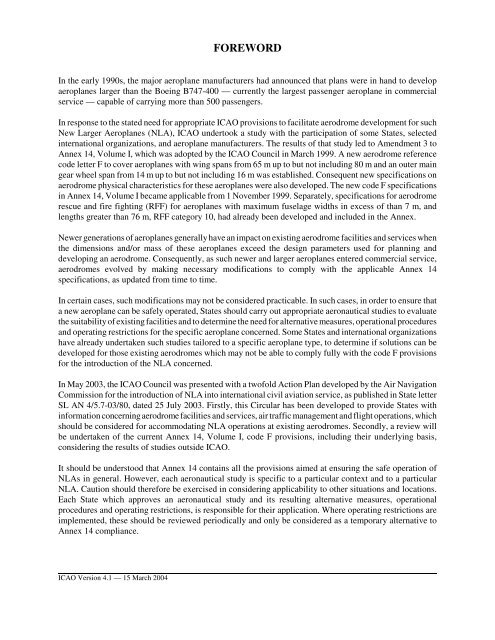Draft ICAO Circular on NLA.pdf - Airports Council International
Draft ICAO Circular on NLA.pdf - Airports Council International
Draft ICAO Circular on NLA.pdf - Airports Council International
Create successful ePaper yourself
Turn your PDF publications into a flip-book with our unique Google optimized e-Paper software.
<str<strong>on</strong>g>ICAO</str<strong>on</strong>g> Versi<strong>on</strong> 4.1 — 15 March 2004<br />
FOREWORD<br />
In the early 1990s, the major aeroplane manufacturers had announced that plans were in hand to develop<br />
aeroplanes larger than the Boeing B747-400 — currently the largest passenger aeroplane in commercial<br />
service — capable of carrying more than 500 passengers.<br />
In resp<strong>on</strong>se to the stated need for appropriate <str<strong>on</strong>g>ICAO</str<strong>on</strong>g> provisi<strong>on</strong>s to facilitate aerodrome development for such<br />
New Larger Aeroplanes (<strong>NLA</strong>), <str<strong>on</strong>g>ICAO</str<strong>on</strong>g> undertook a study with the participati<strong>on</strong> of some States, selected<br />
internati<strong>on</strong>al organizati<strong>on</strong>s, and aeroplane manufacturers. The results of that study led to Amendment 3 to<br />
Annex 14, Volume I, which was adopted by the <str<strong>on</strong>g>ICAO</str<strong>on</strong>g> <strong>Council</strong> in March 1999. A new aerodrome reference<br />
code letter F to cover aeroplanes with wing spans from 65 m up to but not including 80 m and an outer main<br />
gear wheel span from 14 m up to but not including 16 m was established. C<strong>on</strong>sequent new specificati<strong>on</strong>s <strong>on</strong><br />
aerodrome physical characteristics for these aeroplanes were also developed. The new code F specificati<strong>on</strong>s<br />
in Annex 14, Volume I became applicable from 1 November 1999. Separately, specificati<strong>on</strong>s for aerodrome<br />
rescue and fire fighting (RFF) for aeroplanes with maximum fuselage widths in excess of than 7 m, and<br />
lengths greater than 76 m, RFF category 10, had already been developed and included in the Annex.<br />
Newer generati<strong>on</strong>s of aeroplanes generally have an impact <strong>on</strong> existing aerodrome facilities and services when<br />
the dimensi<strong>on</strong>s and/or mass of these aeroplanes exceed the design parameters used for planning and<br />
developing an aerodrome. C<strong>on</strong>sequently, as such newer and larger aeroplanes entered commercial service,<br />
aerodromes evolved by making necessary modificati<strong>on</strong>s to comply with the applicable Annex 14<br />
specificati<strong>on</strong>s, as updated from time to time.<br />
In certain cases, such modificati<strong>on</strong>s may not be c<strong>on</strong>sidered practicable. In such cases, in order to ensure that<br />
a new aeroplane can be safely operated, States should carry out appropriate aer<strong>on</strong>autical studies to evaluate<br />
the suitability of existing facilities and to determine the need for alternative measures, operati<strong>on</strong>al procedures<br />
and operating restricti<strong>on</strong>s for the specific aeroplane c<strong>on</strong>cerned. Some States and internati<strong>on</strong>al organizati<strong>on</strong>s<br />
have already undertaken such studies tailored to a specific aeroplane type, to determine if soluti<strong>on</strong>s can be<br />
developed for those existing aerodromes which may not be able to comply fully with the code F provisi<strong>on</strong>s<br />
for the introducti<strong>on</strong> of the <strong>NLA</strong> c<strong>on</strong>cerned.<br />
In May 2003, the <str<strong>on</strong>g>ICAO</str<strong>on</strong>g> <strong>Council</strong> was presented with a twofold Acti<strong>on</strong> Plan developed by the Air Navigati<strong>on</strong><br />
Commissi<strong>on</strong> for the introducti<strong>on</strong> of <strong>NLA</strong> into internati<strong>on</strong>al civil aviati<strong>on</strong> service, as published in State letter<br />
SL AN 4/5.7-03/80, dated 25 July 2003. Firstly, this <str<strong>on</strong>g>Circular</str<strong>on</strong>g> has been developed to provide States with<br />
informati<strong>on</strong> c<strong>on</strong>cerning aerodrome facilities and services, air traffic management and flight operati<strong>on</strong>s, which<br />
should be c<strong>on</strong>sidered for accommodating <strong>NLA</strong> operati<strong>on</strong>s at existing aerodromes. Sec<strong>on</strong>dly, a review will<br />
be undertaken of the current Annex 14, Volume I, code F provisi<strong>on</strong>s, including their underlying basis,<br />
c<strong>on</strong>sidering the results of studies outside <str<strong>on</strong>g>ICAO</str<strong>on</strong>g>.<br />
It should be understood that Annex 14 c<strong>on</strong>tains all the provisi<strong>on</strong>s aimed at ensuring the safe operati<strong>on</strong> of<br />
<strong>NLA</strong>s in general. However, each aer<strong>on</strong>autical study is specific to a particular c<strong>on</strong>text and to a particular<br />
<strong>NLA</strong>. Cauti<strong>on</strong> should therefore be exercised in c<strong>on</strong>sidering applicability to other situati<strong>on</strong>s and locati<strong>on</strong>s.<br />
Each State which approves an aer<strong>on</strong>autical study and its resulting alternative measures, operati<strong>on</strong>al<br />
procedures and operating restricti<strong>on</strong>s, is resp<strong>on</strong>sible for their applicati<strong>on</strong>. Where operating restricti<strong>on</strong>s are<br />
implemented, these should be reviewed periodically and <strong>on</strong>ly be c<strong>on</strong>sidered as a temporary alternative to<br />
Annex 14 compliance.

















